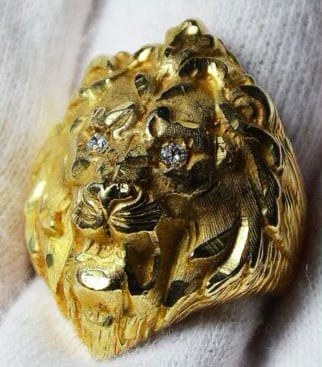Ever wonder where all that gold comes from? About one-fourth of the world’s needs each year comes from recycled gold, which is why Dallas Gold & Silver Exchange has been buying the precious metal with fair prices, integrity and transparency for more than four decades. But as hard as we work, it’s not enough. So the world has to dig up the rest, on every continent except Antarctica. If you like Top Ten Lists, the annual GFMS Gold Survey has just been released with country-by-country totals for 2017. First, the big picture: overall production was 3,247 tonnes (also known as metric tons, which is 1,000 kilos, or about 2,200 pounds) down only 5 tonnes from 2016 but the first time the number has declined since 2008. Analysts cited environmental concerns, rising costs of sophisticated mining operations and crackdown on illegal mining in some countries as factors. Here are the leading gold-producing countries: China, 426 tonnes, down 6 percent but by far the most in the world. Australia, 295 tonnes. Russia, 271 tonnes. United States, 230 tonnes, with three-fourths of that in Nevada alone. Canada, 176 tonnes, up from No. 7 in 2016. Peru, 162 tonnes. Indonesia, 154 tonnes. South Africa, 140 tonnes. The former world leader has been steadily declining in the last decade. Mexico, 131 tonnes, 2 1/2 times the total 10 years ago. Ghana, 102 tonnes. Don’t forget to print this out for your next trivia contest. And if you have broken jewelry, unwanted pieces or bullion, or rare coins stop by Dallas Gold & Silver Exchange to turn your own gold mine into hard cash. The world is counting on us.
Monthly Archives: June 2018
Fix Your Jewelry With Us – Except If It Belonged To Elvis If your jewelry breaks, you should fix it, and the repair experts at Dallas Gold & Silver Exchange are your best bet. But here’s one case when leaving it broken might have been the right call. Last weekend an auction house in England sold a gold lion-head ring, with little diamonds for eyes, in not the greatest condition, for just over $44,000. Why was it worth so much? Because it belonged to Elvis Presley, the King of Rock and Roll who loved the King of the Beasts. The ring was accompanied by a certificate of authenticity signed by Elvis pal Jimmy Velvet, who noted that the legendary singer was wearing the 14k ring at his Graceland home in 1972. “One night at Graceland, Elvis dropped the ring on the floor and one of his Memphis Mafia members accidentally stepped on it and smashed it,” he wrote. “Elvis handed the ring to his cousin and told her to have the ring fixed. He told her that she could keep the ring if it couldn’t be fixed.” Without explaining why, he added, “The ring was never repaired.” So she kept it. The British seller and the American buyer weren’t identified. To mark the occasion, here’s a clip of Elvis singing, of course, “Wear My Ring Around Your Neck.” Here’s the link in case it didn’t embed: https://www.youtube.com/watch?v=UxaW9WZwXjs
Looking For Trends? Try These On Should be you getting into ear stacks? Talismans? Opals and emeralds? JCK, a leading jewelry industry magazine, convened its annual trade show in Las Vegas last week, billed as the country’s largest exposition of what’s hot and what’s new. For a panel discussion on those subjects, the magazine convened three fashion forecasters, Shane Clark, Kareem Rashed and Lauren Eggertsen, along with its own editors. The full report is here, but in case you just want the highlights: Younger buyers are embracing fine jewelry and popular designers more than ever, and pairing those choices with fancy couture. When new princess Meghan Markle flashed a big aquamarine ring that once belonged to Harry’s mom Diana, she probably set off a stampede to beautiful blue stones. Current buzzwords you need to work into the conversation include shell-motif earrings and necklaces, bypass rings (that don’t close in a circle), rainbow palettes (jewelry with stones of many colors) and edgy pearls, a modern version of grandma’s favorite. There are lots of ways to stack jewelry – earrings that climb up your ear, side-by-side-by-side diamonds in an engagement ring (which Meghan is bringing back into style), and layers of necklaces with pendants displaying monograms, zodiac signs or amulets. Look out for Lucite, the translucent material that’s been around since the ‘30s but still trendy, because it can be molded and colored in endless ways. Trendy or classic, vintage or cutting edge, you’ll find it at Dallas Gold & Silver Exchange. And you’ll save enough to be ready for the next trend as well.
An Intoxicating Way to Think About Gold There are many ways to assess the worth of gold, including its dollar value, comparison to the stock market, or whether it beats the inflation rate. Since 1950, a Liechtenstein-based asset management company called Incrementum has another method: how much beer will it buy? And in that measurement, gold is down slightly, but still solid in the long term. Incrementum just released its 12th annual “In Gold We Trust” report, declaring that the precious metal is in the early stages of a new bull market. “From our point of view, stronger inflation tendencies or the abandoning of the rate-hike cycle in the US could trigger an increase in momentum of the gold price,” the authors declare. The 230-page report, available here, is full of charts and graphs and analyses that probably require a finance degree to fully understand. But one of its elements, the gold/beer calculation, goes down easy. For 68 years, the company has tracked the price of a liter of beer at the famed Munich Oktoberfest alongside the price of an ounce of gold. The all-time high, if you’re keeping score, was in 1980, when an ounce of gold bought you 227 German brews. Only nine years earlier it had hit the all-time low of just 48. The total for 2017 was 99, down a few liters from the previous year but still well above the historical median of 87. Reaction to the golden update was mixed. “I have no idea what I just read,” wrote one commenter on mining.com, which reported the news. “But now I want some gold and a beer.”
A Tale of Two Precious Metals Platinum or gold? Right now the first option is on the upswing. Platinum Guild International, which tracks sales around the world, reports that platinum jewelry sales in the U.S. rose 11 percent in 2017 over the previous year, outshining the 3 percent rise for gold jewelry. “Platinum is a natural white metal, and white is popular right now,” says Karen Wood, vice president for service at Dallas Gold & Silver Exchange and one of our resident experts on the subject. “But it has its pros and cons.” First, a look at the pros: Platinum implies prestige (your “platinum” credit card has more benefits than your “gold” credit card) and is more durable than gold, which can wear down or scrape off over time. Platinum is denser and stronger, and its prongs will hold a diamond or other gemstone more securely. That’s particularly important for a big stone. Because it’s used in a nearly pure form, platinum is considered hypoallergenic. Gold is softer and needs to be mixed with alloys – usually nickel or copper – which trigger allergic reactions in some people. White gold gets its white metal look through rhodium plating, which wears off over the years and needs to be refinished. Platinum merely needs to be polished. Now the cons: Even though platinum is cheaper than gold (currently about $900 per ounce versus $1,300 for gold), platinum jewelry can be much more expensive. That’s because platinum jewelry is much more pure than gold jewelry, so you’re paying for more precious metal and less alloy, and may require more workmanship. Platinum jewelry will also be heavier to wear, which not everyone may like. It also can blemish or scratch more easily than a softer, more malleable metal. The harder metal does not hold small stones as well and is more difficult to filagree, or use thin metal strands to create intricate designs. The bottom line? There isn’t just one, which is why you should come in for a test drive and decide what’s right for you.





